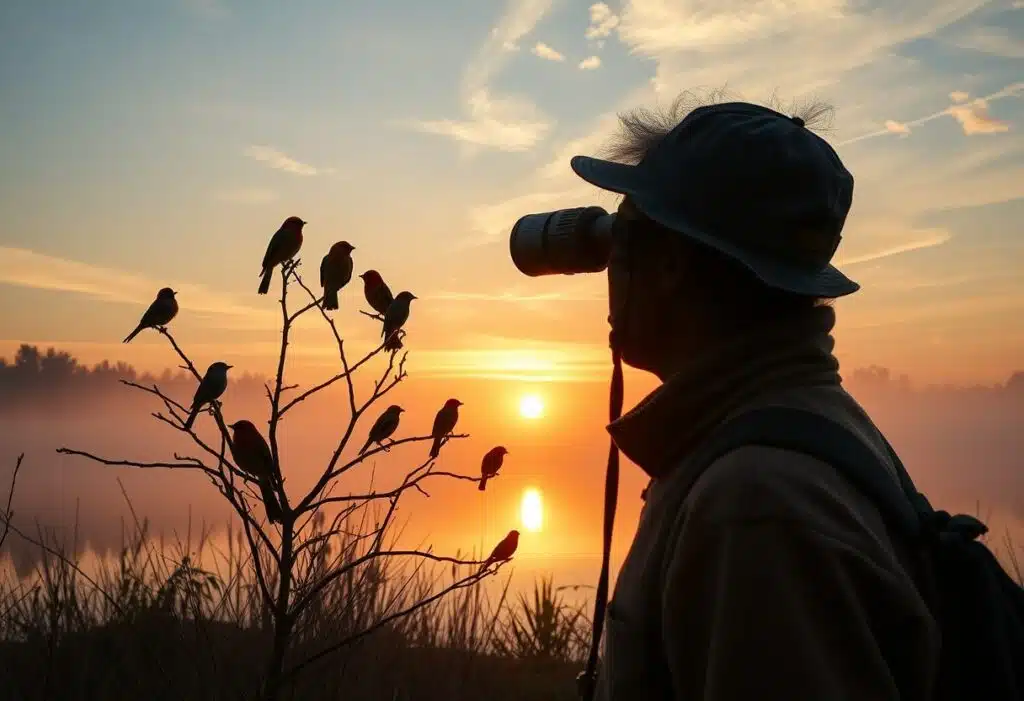What Time of Day is Best for Bird Watching?: A Beginner’s Birding Guide
There’s nothing quite like the thrill of birdwatching to connect you with nature. If you’re wondering when the best time for birding is, consider early morning and late afternoon. best time of day to go birding is, you’ll want to rise with the sun. Early mornings are when many birds are most active, singing and foraging as the world around them awakens. However, the late afternoon also offers a wonderful chance to see Hawks are among the most fascinating bird species to observe while birdwatching. and other bird species searching for their last meals. Let’s look into the perfect times to grab your binoculars and enjoy the magic of birding!

Key Takeaways:
- Best time of day: The ideal time for birdwatching is in the early morning, especially right at sunrise. Many birds, like songbirds, are very active and can be heard singing happily. It’s the perfect time to see those beautiful feathered friends!
- Late morning and afternoon: After the busy morning, bird activity slows down a bit. However, you may still spot raptors such as hawks and falcons during the late morning or afternoon, as they search for their next meal, taking advantage of the warmer temperatures.
- Evening and night: As the sun sets, many birds become active again, especially in the late afternoon, making it a great time for birding. For night owls, it’s a rare chance to look for owls and other nocturnal species, but keep in mind that they’re harder to see. You’ll be lucky to catch a glimpse of a great horned owl or a black-crowned night heron!
Whether you’re a seasoned birder or just getting started, planning your birdwatching around these times will help you see the most birds and enjoy every moment of your adventure in nature. Grab your binoculars and get ready to connect with the birding community!
The Best Time of Day for Birdwatching
Before you grab your binoculars and head out, keep an eye on the clock. The best time of day for birdwatching tends to be in the early morning, right around sunrise, when you can catch many birds as they wake up and start their daily routines. The quiet early hours bring an abundance of songbirds singing and foraging, making it an ideal time for both new and seasoned birders.
Early Morning: The Peak of Bird Activity
Morning is when you’ll find the most bird activity. As the sun rises, songbirds announce their presence with beautiful melodies, and early morning is the best time to hunt for food. This is your chance to see a variety of bird species, engaged and lively, no matter what time of day.

Late Morning/Early Afternoon: Raptors Take Center Stage
Below the hustle of early birds, you may notice that many birds start to quiet down. However, this time is prime for spotting raptors such as hawks and falcons, which become more active as the sun climbs higher in the sky, aiding their hunting efforts.
Also, this period can reveal stunning aerial displays from birds of prey, as they take advantage of rising thermals, soaring effortlessly. Keep your binoculars focused, as these magnificent predators showcase their hunting finesse.
Mid-Afternoon: Birds Take a Break
Best to take a break mid-afternoon, when the heat of the day slows the bird activity. Birds often seek shade and rest, conserving energy during the hottest part of the day. If you’re eager to see them, consider visiting your local bird feeder.
This quieter time does not mean the end of birdwatching; simply be patient and enjoy the bird migration. You might spot some feeders bustling with activity from birds looking for a snack or even taking a cool bath to refresh.
Late Afternoon/Early Evening: Activity Picks Up Again
Break out your binoculars once more as late afternoon rolls in. As the sun starts to dip, birds become active again, foraging for one last meal before nightfall. This is often a fantastic time to catch glimpses of various species preparing for their nighttime roost.
Hence, as you observe the birds gathering and flitting about, take note of their behaviors. This time can produce some of the best sightings as the day transitions into twilight.
After Dark: Owls and Nocturnal Birds
Picks of the night reveal a different avian world. While many species go silent and roost, you might catch a glimpse of elusive owls and other nocturnal birds. Their mysterious presence adds a unique twist to your birdwatching experience, especially for avid Audubon enthusiasts.
For instance, spotting a great horned owl or a black-crowned night heron can be thrilling, as these species are specially adapted for nighttime hunting. Just remember to be quiet and patient—observation is key during these enchanting hours.

The Best Time of Year for Birdwatching
Not every season offers the same opportunities for birdwatching. Each time of year reveals unique patterns of bird activity that can shape your experience. Whether you’re tracking migratory birds or observing local species in their habitats, understanding the best times can enhance your birdwatching adventures.
Spring: Migratory Birds and Nesting Season
Season changes bring a vibrant rush of activity as migratory birds return to their breeding grounds. From early March, you’ll witness the return of many species, like warblers and songbirds, busy building nests and staking out territories. The air fills with birdsong, making it one of the most energetic times for birdwatching.
Summer: Nesting and Routines
Migratory birds settle into their new homes and focus on raising their young. Throughout the summer months, you’ll notice more predictable routines. Birds like woodpeckers and jays are in full nesting mode, hunting for food in the morning, resting during the hottest part of the day, and coming out again for a late meal as daylight fades.
Even simple backyard feeders can attract colorful visitors during this season—much like a front-row seat to avian life. Setting up bird feeders in shaded areas will greatly increase your chances of seeing more birds. You can relish the sight of parents bringing food to their chicks, creating a dynamic atmosphere full of life and activity.
Fall: Migration and Subtle Tactics
One of the most exciting times for birdwatching comes in the fall, as migratory birds begin their journeys south. Some birds leave as early as late August, while others may linger until mid-October, depending on the weather. (This is a great chance to see various species you may have missed during the year, especially if you go birdwatching.)
Routines and patterns shift as birds adapt to the changing environment. In addition to traditional V formations seen in migrating geese, you may discover turkeys and pheasants employing quieter, subtler migration tactics. With the changing light and the crisp air, you might view many species more closely as they prepare for their long journeys.

Winter: Survival and Easy Spotting
To survive the harsh winter months, birds become less active, conserving energy while they huddle together for warmth, a crucial time of the year for birdwatching. Yet, this is also a prime time for spotting them! Without leaves on the trees, vibrant birds like cardinals and blue jays become easy to see and observe, their colors stark against the stark white backdrop, making it excellent birding.
Easy visibility in winter can provide unexpected thrills, as many birds of North America congregate at feeders for some extra nutrition. Take opportunities to visit local parks or your own backyard to watch birds interact, making this season surprisingly engaging for birders eager for a glimpse of winter wildlife.
Get Closer to Nature
Once again, birdwatching invites you to reconnect with the wonders of the natural world, especially during spring and fall. There’s something truly special about waking up at dawn, when birds are most active and their enchanting songs fill the air. The early morning is the prime time for birdwatching, especially for spotting various bird species. best time of day for birdwatching; it’s when you can see everything from lively songbirds to soaring hawks. If you’re curious about the positive aspects of this hobby, check out everything you need to know to get started birding at the Cornell Lab of Ornithology. The Unexpected Benefits of Birding. With your binoculars in hand, you’ll discover the joy of observing many species as they forage and interact in their habitats.
Final Words
So, if you’re looking to examine the wonderful world of birdwatching, make the early morning your special time. This is when birds are most active, singing and foraging as the sun begins to rise. Late afternoon also offers a burst of activity as they prepare for the night. With your binoculars in hand, you’ll be sure to see many birds, from songbirds to majestic hawks. As you venture out, immerse yourself in nature and enjoy every moment—it’s all part of the birding experience!
FAQ
Q: What is the best time of day for birdwatching?
A: The best time of day for birdwatching is early in the morning, especially around sunrise, when many bird species are most active. This is when many birds are most active and you can hear them singing. If you’re a new birder, getting up early gives you the best chance to go birdwatching and see a variety of birds.
Q: Are there good times to go birding later in the day?
A: Yes! Late morning and late afternoon can also be good times for birding. In the late afternoon, birds like songbirds start to forage again, and you might see hawks becoming active as they prepare for their evening hunts. There’s always something happening!
Q: What types of birds are active at different times of day?
A: During the early morning, you’ll see many songbirds singing and being very active. In the late afternoon, you might see raptors and waterfowl getting ready for their night. Owls and some waterbirds are more active at night, so there’s always something to enjoy no matter the time of day.
As a bird enthusiast with a passion for sharing the wonders of our feathered friends. As a writer and nature lover, I'm thrilled to connect with fellow bird buffs and inspire others to take flight into the fascinating world of birds. Let's wing it together!


